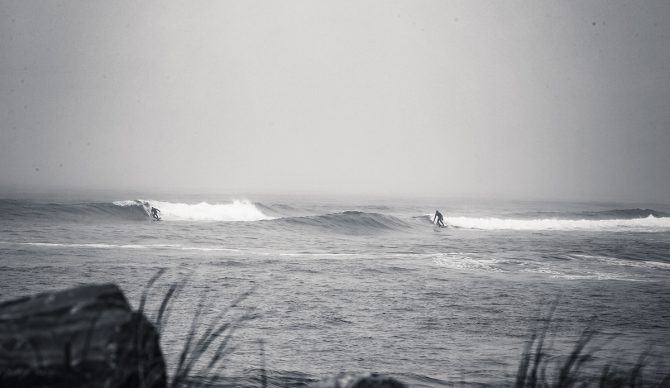The first place most people think about when evoking Canada’s surf scene is typically Tofino, B.C. It’s a great little town nestled out on a point on Vancouver Island. Summers offer a great party scene and mediocre breach break, oddly familiar to Surf City, USA, aka Huntington Beach, California. Winters in Tofino come with a cozy and slow-paced life and some great surf amidst near-freezing air temperatures and endless rain.
Meanwhile, Ottawa, Ontario has been my home for the past 10 years. And while Tofino is where I caught my first wave — like most Canadians — Ottawa is where I’ve fallen in love with and refined my surfing skills. “How do you surf there? It’s landlocked,” people will often say to me on my travels around the U.S. and Canada.

John Rathwell drops in on the Lawrencetown Right in Nova Scotia. Photo: Tracy Guenard.
Ottawa is, in fact, a bit of a drive to the open ocean. One of our closest ocean waves is 14-hours away, in Lawrencetown. The righthand point is totally worth the road trip, especially in the fall when it runs more consistently. And while a 14-hour drive to surf a freezing cold wave doesn’t make much of a case for Ottawa as a surf destination, we have plenty of more accessible options if you’re willing to give up your attachment to saltwater. The Champlain Bridge, Sewer Wave, and Desert Wave are all found on the mighty Ottawa River, right in the city.
Champlain Bridge is my favorite of the bunch. Parking is easy on Bate Island and the main wave packs a bit of a punch, forming a shoulder similar to an ocean wave. The main wave works like clockwork. You can bet that every spring you’ll see it, just as the snow starts to melt with the spring runoff.

Dave Crichton takes to the air on the main wave of Champlain Bridge in Ottawa ON. Photo: John Rathwell
The spot offers a few waves to surf depending on your style. There is the Top Wave, which is a blast on a longboard or fish.. Far Side is also great on a longboard and isn’t surfed often. I’ve found myself enjoying 15-minute rides there while the main wave has a 30-40 minute lineup with whitewater kayakers also using it.
The Main Wave is where the action is, though. Its steep shoulder and great catcher’s mitt foam pile allows you to surf shortboards and throw the most radical turns and airs. The pocket is small, so you need speed to unleash in a short amount of time and space.

John Rathwell with a little cheater 5 on the top wave at Champlain Bridge in Ottawa ON. Photo: Tracy Guenard
Sewer Wave is where most folks will head once the water level on the river is too low for Champlain Bridge. Some folks think this is actually a better wave, but it is nicknamed “Poo Pipe” for good reason. A sewer outlet is, in part, what helps form the wave. Surfers wade across the water right below the sewer outlet before grabbing a rope to tow in. If the sewer outflow is particularly gross, you can opt to jump in above the sewer. It’s a great place to surf late spring/early summer, and if you’re lucky, most of the winter. It can be fun on a shortboard or longboard. And while the wave is friendlier looking than Champlain Bridge, shallow water and rocks below make for broken fins, boards, and gnarly charlie horses.
The Dessert Wave is special in Ottawa. It is surfable year round unless an ice shelf forms behind it in the winter. But in terms of water levels, it is always surfable, from the highest highs to the lowest lows, making it a great summer wave when the low water hits. It does have a few catches though. At high water, it turns into a giant green face, and you need a jet ski to step off onto it. The other catch is that it is in the middle of the Ottawa River, making it a big swim out to the wave and back onto shore. That being said, it’s totally worth the effort.
If paddling out to the middle of the Ottawa River isn’t your thing but you’re desperate for summertime waves, you can head to Montreal. Just two hours from Ottawa, Montreal has a great river surfing scene with multiple waves. School Wave is a great beginner and longboard option, or head downstream to Habitat 67 if you want to surf something a little larger. If you really want to step up, you will have to grab your ski again to hit up some of the XL waves in the middle of the Lachine Rapids.
By the time fall rolls around in Ottawa, you may be getting a little tired of surfing rivers. And that’s when you’ll start looking at Lake Ontario and the Great Lakes. Hurricanes and winter storms push large wind swells into the shores with rippable surf. Conditions can be hit or miss, but when you hit them you are sure to score. You might even forget that you are surfing on a lake.
So that’s my case for declaring Ottawa as Canada’s surf capital. If you’re willing to work for it, you can surf year round on a variety of waves.

